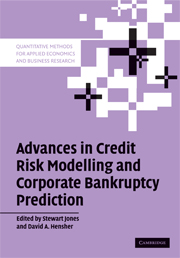Book contents
- Frontmatter
- Contents
- List of figures
- List of tables
- List of contributors
- Introduction
- 1 A statistical model for credit scoring
- 2 Mixed logit and error component models of corporate insolvency and bankruptcy risk
- 3 An evaluation of open- and closed-form distress prediction models: The nested logit and latent class models
- 4 Survival analysis and omitted dividends
- 5 Non-parametric methods for credit risk analysis: Neural networks and recursive partitioning techniques
- 6 Bankruptcy prediction and structural credit risk models
- 7 Default recovery rates and LGD in credit risk modelling and practice: An updated review of the literature and empirical evidence
- 8 Credit derivatives: Current practices and controversies
- 9 Local government distress in Australia: A latent class regression analysis
- 10 A belief-function perspective to credit risk assessments
- Index
- References
7 - Default recovery rates and LGD in credit risk modelling and practice: An updated review of the literature and empirical evidence
An updated review of the literature and empirical evidence*
Published online by Cambridge University Press: 11 June 2010
- Frontmatter
- Contents
- List of figures
- List of tables
- List of contributors
- Introduction
- 1 A statistical model for credit scoring
- 2 Mixed logit and error component models of corporate insolvency and bankruptcy risk
- 3 An evaluation of open- and closed-form distress prediction models: The nested logit and latent class models
- 4 Survival analysis and omitted dividends
- 5 Non-parametric methods for credit risk analysis: Neural networks and recursive partitioning techniques
- 6 Bankruptcy prediction and structural credit risk models
- 7 Default recovery rates and LGD in credit risk modelling and practice: An updated review of the literature and empirical evidence
- 8 Credit derivatives: Current practices and controversies
- 9 Local government distress in Australia: A latent class regression analysis
- 10 A belief-function perspective to credit risk assessments
- Index
- References
Summary
Introduction
Three main variables affect the credit risk of a financial asset: (i) the probability of default (PD), (ii) the ‘loss given default’ (LGD), which is equal to one minus the recovery rate in the event of default (RR), and (iii) the exposure at default (EAD). While significant attention has been devoted by the credit risk literature on the estimation of the first component (PD), much less attention has been dedicated to the estimation of RR and to the relationship between PD and RR. This is mainly the consequence of two related factors. First, credit pricing models and risk management applications tend to focus on the systematic risk components of credit risk, as these are the only ones that attract risk-premia. Second, credit risk models traditionally assumed RR to be dependent on individual features (e.g. collateral or seniority) that do not respond to systematic factors, and therefore to be independent of PD.
This traditional focus only on default analysis has been partly reversed by the recent increase in the number of studies dedicated to the subject of RR estimation and the relationship between the PD and RR (Fridson et al. 2000, Gupton et al. 2000, Altman et al. 2001, Altman et al. 2003, 2005, Frye 2000a, 2000b, 2000c, Hu and Perraudin 2002, Hamilton et al. 2001, Jarrow 2001 and Jokivuolle and Peura 2003). This is partly the consequence of the parallel increase in default rates and decrease of recovery rates registered during the 1999–2002 period.
- Type
- Chapter
- Information
- Publisher: Cambridge University PressPrint publication year: 2008
References
- 24
- Cited by



